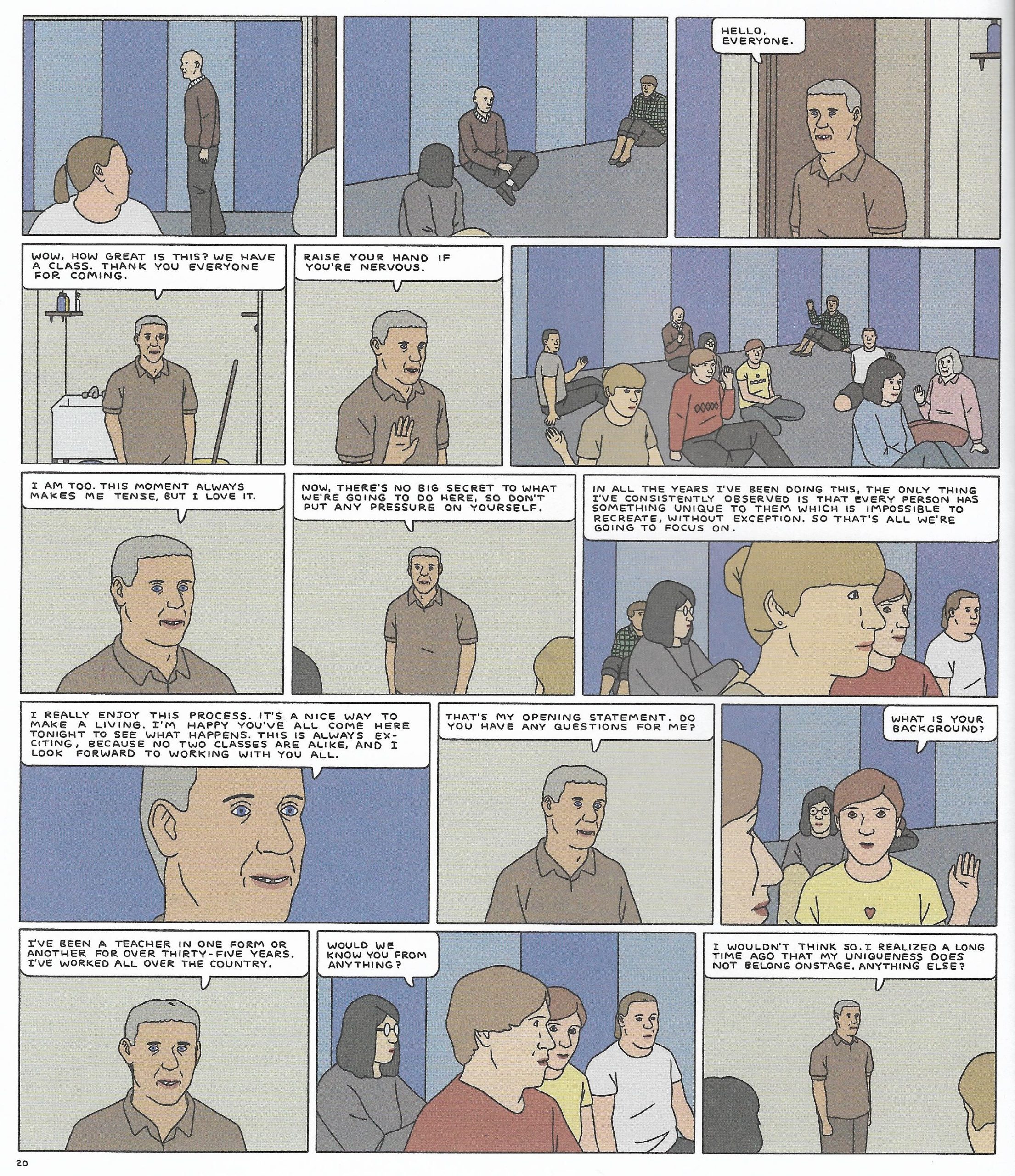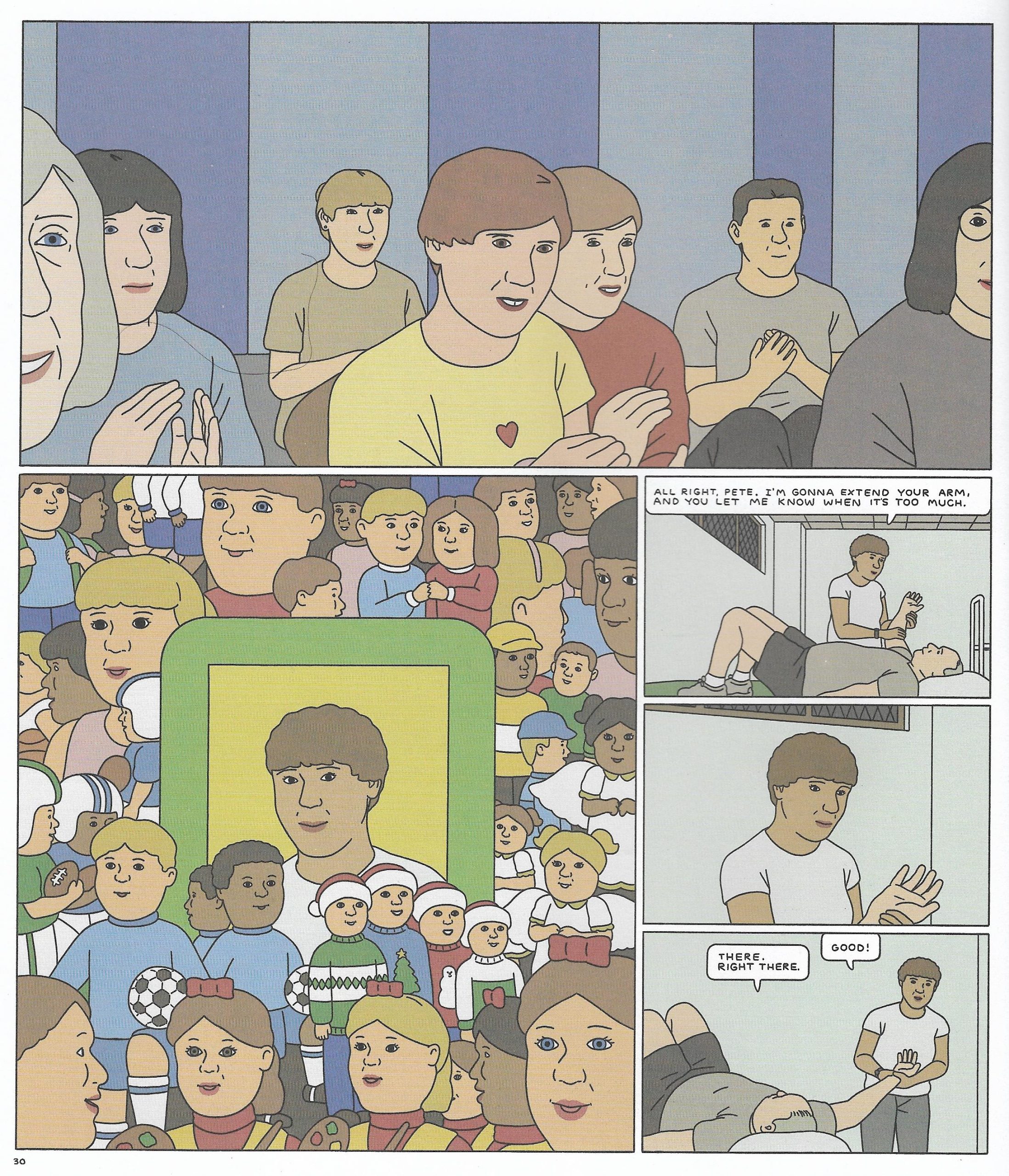In America, the confluence of military propaganda, declining wages and media oversaturation have led a large number of people—particularly people who are white heterosexuals—to have a crisis of faith in the prospect of any actual improvement in their quality of life. Concomitant trauma, middle class mental illnesses (accompanied by a suite of ineffective therapies) and real, horrible life circumstances have prompted a genuine shock in much of the formerly golden-yeared population: that their promised lives might have always been fated to meander endlessly in a sea of mediocre approximations of things they once thought they might like.
Let me back up a little bit. Nick Drnaso is a cartoonist of white mediocrity. His previous effort, Sabrina, garnered significant praise from the publishing establishment. You might have heard of this. Acting Class, his newest comic, is about a group of listless individuals who attend the eponymous workshop, where they are forced to unearth parts of themselves they find bleedingly uncomfortable despite their very attachment to this discomfort. In classical fashion—familiar to those who have read any canonical works of American fiction written in the last 50 years— discomfort is what keeps them going. A reciprocal relationship between shame, fear and boredom allows them to maintain their tethers to normal (that is, white middle class) reality. Drnaso is a veritable master in this mode of depiction. I say this not because the colors are flat, or the cartooning is flat, or that the drained affect of the whole piece gestures toward a retread of his artistic forbearers in the realm of Bookstore Cartooning, whose patron saints count among their numbers Daniel Clowes, Chris Ware and Ivan Brunetti. There is nothing, on its own, provocative or interesting about saying Nick Drnaso’s style looks like Chris Ware. No, I say this because Drnaso actually executes less than the aforementioned artists - and less is more in this context. More bounded, more square. Flatter, less affect, less bravery. Less of everything except dialogue. And all of this is actually much more beneficial to his project than some formal adventurousness that draws eyes, elicits oohs and ahhs, and leaves heads being scratched or barriers being erected between the reader and the cartoonist. Drnaso’s is the triumph of clarity in its flatness. The absolute confirmation of readable lucidity. I bet it took a very long time to draw this book.
If any of this sounds sarcastic or like an underhanded jab at the quality of the work, it’s absolutely not. I am confirming, actually, how this sort of thing operates, and that it operates quite well.
So, yes: non-imagination. Acting Class isn’t fun. It can be funny, but it is by no means supposed to excite or arouse a sense of glee in the art of its execution. The characters, visually, run together. Their facial expressions are scant, and at times difficult to discern. They are, even in their psychological complexity, boring people. What is interesting, however—and this is the premise of the book—is the overwhelming desire of Drnaso’s characters to escape the existential entrapment of societally-conditioned boredom. To become imaginative, and to resist the structural reasons why and how they got to be so self-loathing, angry and lost. This desire is enacted through performance: not for others, but fundamentally for oneself. To get to be someone or something else in a new reality where you can be a whole person. The tension of Acting Class, visually and narratively, is located in whether or not this is possible.
In one sequence, the members of the class are prompted to make facial expressions to one another, and then guess the emotion their scene partner is attempting. It begins relatively simply with presentations of “anger” and “happiness”, but as the members of the class fragment into two-person groups, things become significantly more complex to discern. Considering Drnaso’s visual style, with its slightness of facial diversity, this is also difficult for the reader. At the beginning of the scene, everything is spelled out. Dialogue boxes point to the corresponding expression, subsequently coloring the viewer’s understanding of what a given character’s expression is attempting. A few pages later, however, the dialogue drops away, and the viewer is left to her own devices in discerning these expressions. This sequence carries on for about four or five pages. Ultimately it serves as a demonstration of one of the main art/narrative coherences of Acting Class - and, as a matter of equal importance, Drnaso’s mastery of his own style. He is acutely aware that his figuration and facial cartooning are not specifically interesting to look at in the conventional sense. It is obviously stripped back to a degree that permits a level of ambiguity for the reader, such that she can form her own opinion on the purpose of the expressions. Again, non-imaginative rather than unimaginative.
The central challenge, then—for both the reader and the characters of Acting Class—is whether or not imagination is, for them, even possible. Unfortunately, in order to arrive at this place of “imagination” there is a great deal of necessary self-knowledge required. In this context, of course, Drnaso follows the characteristic artist’s thesis that imagination, as an emotive experience, is inherently linked to self-fulfillment and actualization; whether this is actually true or indicative of any structural argument within the neoliberal cultural collapse of the 21st century is hopelessly ambiguous and poorly articulated. The thesis on society, as far as Drnaso is willing to push it, is 'people are sad and homogenous'. But there are glimpses of freedom that appear in Acting Class. Any time a full-, half-, or quarter-page splash is attempted, it is intricate, otherworldly, and striking in its rendering of some attempt at a better reality than the one we live in. Structurally, in the midst of Drnaso's low-affect pages, these gestures of escape entice the reader as much as they might entice the character whose imagination is depicted in the panel.
What do these characters do in their simulacra, when they perform their escape? They all have key problems that they negotiate. Rayanne wants to be a good mother. Dennis wants to be confident and important. Angel wants a freewheeling lifestyle. Lou wants to be a dog. These come with their requisite barriers. Rayanne is horrified that she’s ruining her child’s life, and that something is fundamentally wrong with her; Dennis is meek and has trouble expressing his desires; Lou is not a dog and cannot be a dog; etcetera. Their performances in the Acting Class give them access to an environment where they can enact the potential of failure without the consequences of internalization or repression. And, in their enactments, they can actually surpass the elements of life—that is, those parts of life informed by the context of work, family trauma or money—to achieve a sustainable representation of their desires. The assumption of all of the characters is that they will eventually take what they learned in these representative simulacra and apply it to life in the confines of society. But the essential problem is that none of these desires can be actualized in accordance with actual organized social life. Lou cannot be a dog.
The comic ends in a reveal that the Acting Class is a recruitment program for a larger, more unified class that apparently performs in a communal, cult-coded setting. In order to actualize the self and the realm of imagination, the actor must leave society behind to join a communal alternative. To get in the white conversion van that ferries them to the never-ending scenario. To, effectively, become someone else, somewhere else, in a place that doesn’t actually exist in reality. Instead, the actor inhabits a simulacrum, which is distinct from a simulation, in that it makes no distinction between reality and not-reality. In the same way, save for the imaginative splashes mentioned above, Drnaso does not make any visual distinction between reality and not-reality in his art. The simulacrum is a place that becomes more real than reality in its execution of the individual’s pure self-enacting of their pure desires, so that they can negotiate with these desires. In the confines of Drnaso's book, there is absolutely no room to inhabit reality and to feel personally actualized. At the same time, one cannot perform actualization in a vacuum or on an individual basis. These scenarios have to be experienced collectively. Reality is, within the Acting Class or outside of it, a consensus that people agree upon. The only differences between the two presented options are the presence of externalities we would classify as “societal” in nature. It is never really approached how it would, actually, not be possible to escape society in a mental framework, or how escaping what makes “people sad and homogenous” in society would operate, structurally or collectively. These aren’t interesting questions to Drnaso, so we have to be comfortable with the presentation of “outside” and “inside” being effectively limited to “I get to be happy and have everything I want on the commune, but I’m weird,” or “I get to be miserable, but in conformity with normative values of societal wellbeing.” Again, I don’t think these are correct assessments about how any of this works. They are, however, thematically well-articulated assessments that have narrative weight and emotional valence vis-à-vis the style of cartooning: non-imagination.
I do not have the time, space, or occasion here to discuss how all of this gestures toward previous decades in which culturally stifled, trapped, and very sad people have felt the need to migrate their lives to enclaves outside of society led by a charismatic figure that promises them actualization. Obviously it does. What is important and relevant, however, is that such an intervention is deemed possible in the cultural milieu depicted by Drnaso. To recap: there is no outside of neoliberal reality as it pertains to these characters. There is no chance to effectively escape it, and thus it dictates both the mental landscape of the characters and Nick Drnaso’s mode of depiction. Imagination, as escape, is presented as the only mode of actualization insofar as it can be employed to create a simulacrum of reality; a reality more real than reality, but nonetheless a reality that must be a consensus reality. The fact that this is all might be contentious to the reader is basically necessary. At the very least, it’s strongly implied by the fact that one of the younger characters, Beth, has an exacerbated dissociative episode as a result of the Acting Class. That is, she is in the care of someone who deems her escape to a simulacrum of reality as a negative occurrence. Beth’s caregiver, the oldest member of the class, chooses society for Beth. However, by the end of the book Beth is confined to a mental health facility. She doesn’t get to have society, and she doesn’t get to have the communally-verified mode of imagination certified by the class. She is forcibly placed into the realm of negative imagination, characteristically depicted as falsehood or insanity.
Placed as an epilogue, this is Drnaso’s final word on the subject. That the pursuit of an “outside” of society has to be accomplished communally. Anything else is the realm of non-imagination: the dream society has about itself. Imprisonment in poorly-defined blobs for faces, panel grids, order, insanity, words like “neoliberal”, meaningless responsibilities that we call “clarity” - this is reality. The sticking point, ultimately, is whether or not reality has ever been a choice for anyone in the world.










